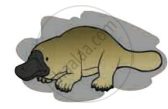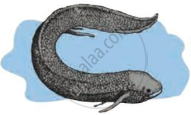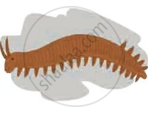Advertisements
Advertisements
प्रश्न
Mammals : _________ : : Amphibia : Fishes
उत्तर
Mammals : Reptiles : : Amphibia : Fishes
APPEARS IN
संबंधित प्रश्न
Differentiate between homology and analogy. Give one example of each.
Which of the following pairs of two vegetables represent the correct homologous structures?
(A) Sweet potato and potato
(B) Sweet potato and tomato
(C) Carrot and potato
(D) Radish and carrot
Write the similarity between the wing of a butterfly and the wing of a bat. What do you infer from the above with reference to evolution?
“Two areas of study namely 'evolution' and 'classification' are interlinked'. Justify this statement.
State a reason for the increased population of dark coloured moths coinciding with the loss of lichens (on tree barks) during industrialization period in England.
Give the importance of fossil in support of organic evolution
Name any two temporary embryonic structures in vertebrates which provide evidence for evolution.
Human tailbone is a vestigial organ. Explain.
The organs which perform different functions but have the same basic structure are known as :
(a) homologous organs
(b) analogous organs
(c) homolytic organs
(d) analytic organs
The organs which perform similar functions but have different basic structure are called :
(a) asymmetric organs
(b) analogous organs
(c) homologous organs
(d) homophonic organs
Wing of an insect and forelimb of a bird are :
(a) analogous organs
(b) analeptic organs
(c) homologous
(d) homophobic organs
The presence of which of the following types of organs in two organisms indicates that they are derived from the same ancestor?
(a) analogous organs
(b) respiratory organs
(c) digestive organs
(d) homologous organs
One pair of organs in the following animals are not homologous. This is :
(a) forelimbs in humans and lizard
(b) forelimbs in lizard and frog
(c) wings in butterfly and bat
(d) wings in bat and bird
The wings of a housefly and the wings of a sparrow are an example of :
(a) analogous organs
(b) vestigial organs
(c) respiratory organs
(d) homologous organs
There are five animals A, B, C, D and E. The animal A uses its modified forelimbs for flying. The animal B uses its forelimbs for running whereas the animal C uses its forelimbs for grasping. The animal D can live on land as well as in water and uses its forelimbs to prop up the front end of its body when at rest. The animal E which respires by using spiracles and tracheae uses wings for flying but its wings are analogous to the modified forelimbs of animal A.
(a) What could the animals A, B, C, D and E be?
(b) Why are the forelimbs of animals A, B, C, D called homologous organs?
(c) What does the existence of homologous organs in animals A, B, C and D tell us about their ancestors ?
(d) Why are the modified forelimbs of animal A and the wings of animal E called analogous organs?
(e) State whether animals A and E have a common ancestor or not.
X, Y, and Z are three animals. The animal X can fly but animal Y can only run on ground or walls. The forelimbs of animals X and Y have the same basic design but they are used for different purposes such as flying and running respectively. The animal Z became extinct an long time ago. The study of fossils of Z tells us that it had some features like those of X and some like those of Y. In fact, Z is said to form a connecting link in the evolutionary chain of X and Y.
(a) What could the animals X, Y and Z be?
(b) What name is given to the forelimbs like those of X and Y which have the same basic design but different functions?
(c) Name one feature in which Z resembled X.
(d) Name one feature in which Z resembled Y.
(e) Which is the correct evolutionary chain involving X, Y and Z : X → Z → Y or Y → Z → X?
Identify the following pairs as homologous and analogous organs:
(i) Sweet potato and potato
(ii) Eye of octopus and eye of mammals
(iii) Thorns of Bougainvillaea and tendrils of Cucurbits
(iv) Fore limbs of bat and whale
Vestigial organ ______ present in human body is proof of evolution.
Write short notes based upon the information known to you.
Connecting link
Long answer question.
Would you consider wings of butterfly and bat as homologous or analogous and why?
Find an odd one out.
Appendix : vestigial organ : : Peripatus : ____________
Give scientific reason.
Peripatus is said to be the connecting link between Annelida and Arthropoda.
Give scientific reason.
Vertebrates have slowly originated from invertebrates.
Write a short note:
Embryological evidences
Explain any five types of evidence that support the theory of evolution.
Write the answers to the questions by observing the figure below.
 |
 |
 |
| (a) | (b) | (c) |
- Write the name of the animal ‘(a)’ in the figure.
- Write the name of the animal ‘(b)’ in the figure.
- Write the name of the animal ‘(c)’ in the figure.
- Which evolutionary evidence is illustrated by this figure?
- Write the definition of that evidence for evolution.
- Define vestigial organs.
- Write names of any two vestigial organs in the human body.
- Write name of those animals in which these vestigial organs are functional.
Palaeontological evidence for evolution refers to the ______.
Appearance of antibiotic-resistant bacteria is an example of ______.
Complete the following chart:

I am the connecting link of annelida and arthropoda. What is my name?
Give a scientific reason.
Morphological evidences suggest that dog, sheep and wolf have a common origin.
Write avian characters of Archaeopteryx.
Write names of some vestigial organs in the human body.
